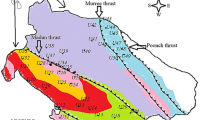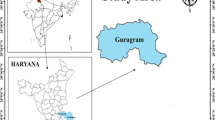Abstract
In this study, measurements of indoor radon (222Rn), thoron (220Rn) and their equilibrium equivalent concentration (EEC) were carried out in 96 dwellings from 22 different villages situated in Hamirpur district, Himachal Pradesh, India, by using LR-115 type II-based pinhole twin cup dosimeters and deposition-based progeny sensors (DRPS/DTPS). The annual average indoor 222Rn and 220Rn concentrations observed in these dwellings were 63.82 and 89.59 Bq/m3, respectively, while the average EEC (attached + unattached) for 222Rn and 220Rn was 29.28 and 2.74 Bq/m3. For 222Rn (f Rn) and 220Rn (f Tn), the average values of unattached fraction were 0.11 and 0.09, respectively. The equilibrium factors for radon (F Rn) and thoron (F Tn) varied from 0.12 to 0.77 with an average of 0.50, and from 0.01 to 0.34 with an average of 0.05, respectively. The annual inhalation dose due to mouth and nasal breathing was calculated using dose conversion factors and unattached fractions. The indoor annual effective doses for 222Rn (AEDR) and 220Rn (AEDT) were found to be 1.92 and 0.83 mSv a−1, respectively. The values of 222Rn/220Rn concentrations and annual effective doses obtained in the present study are within the safe limits as recommended by the International Commission on Radiological Protection for indoor dwelling exposure conditions.








Similar content being viewed by others
References
Bajwa BS, Singh P, Singh P, Saini K, Singh S, Sahoo BK, Sapra BK (2016) A follow-up study on indoor 222Rn, 220Rn and their decay product concentrations in a mineralized zone of Himachal Pradesh, India. Radiat Prot Dosim 168(4):553–560
Dankelmann V, Reineking A, Porstendörfer J (2001) Determination of neutralization rates of 218Po ions in air. Radiat Prot Dosim 94(4):353–357
ICRP (International Commission on Radiological Protection) (1981) Limits of inhalation of radon daughters for workers. ICRP Publication-32, Annals of Vol. 6(1). Pergamon Press, Oxford
ICRP (International Commission on Radiological Protection) (1993) Protection against radon-222 at home and at work. ICRP Publication-65. Pergamon Press, Oxford
ICRP (International Commission on Radiological Protection) (2007) The 2007 recommendations of ICRP. ICRP Publication-103. Pergamon Press, Oxford
ICRP (International Commission on Radiological Protection) (2011) Lung cancer risk from radon and progeny and statement on radon. ICRP Publication-115. Pergamon Press, Oxford
Knutson EO (1988) Modeling indoor concentrations of radon’s decay products. In: Nazaroff WW, Nero AV Jr (eds) Radon and its decay products in indoor air. Wiley, New York, pp 161–199
Mayya YS, Mishra R, Prajith R, Sapra BK, Kushwaha HS (2010) Wire-mesh capped deposition sensors: novel passive tool for coarse fraction flux estimation of radon thoron progeny in indoor environments. Sci Total Environ 409(2):378–383
Mishra R, Mayya YS (2008) Study of a deposition-based direct thoron progeny sensor (DTPS) technique for estimating equilibrium equivalent thoron concentration (EETC) in indoor environment. Radiat Meas 43:1408–1416
Mishra R, Mayya YS, Kushwaha HS (2009a) Measurement of 220Rn/222Rn progeny deposition velocities on surfaces and their comparison with theoretical models. J Aerosol Sci 40:1–15
Mishra R, Sapra BK, Mayya YS (2009b) Development of an integrated sampler based on direct 222Rn/220Rn progeny sensors in flow-mode for estimating unattached/attached progeny concentration. Nucl Instrum Methods Phys Res B 267:3574–3579
Mishra R, Prajith R, Sapra BK, Mayya YS (2010) Response of direct thoron progeny sensors (DTPS) to various aerosol concentrations and ventilation rates. Nucl Instrum Methods Phys Res B 268:671–675
Mishra R, Sapra BK, Mayya YS (2014) Multi parametric approach towards the assessment of radon and thoron progeny exposures. Rev Sci Instrum 85:022105
Nair MK, Nambi KS, Amma NS, Gangadharan P, Jayalekshmi P, Jayadevan S, Cherian V, Reghuram KN (1999) Population study in the high natural background radiation area in Kerala, India. Radiat Res 152:S145–S148
Nero AV Jr (1988) Radon and its decay products in indoor air: an overview. In: Nazaroff WW, Nero AV Jr (eds) Radon and its decay products in indoor air. Wiley, New York, pp 1–53
Nikezic D, Yu KN (2005) Are radon gas measurements adequate for epidemiological studies and case control studies of radon induced lung cancer? Radiat Prot Dosim 113:233–235
Porstendörfer J (1994) Properties and behavior of radon and thoron and their decay products in the air. J Aerosol Sci 25:219–263
Porstendörfer J (1996) Radon: measurement related to dose. Environ Int 22(1):563–583
Porstendörfer J (2001) Physical parameters and dose factors of the radon and thoron decay products. Radiat Prot Dosim 94(4):365–373
Sahoo BK, Sapra BK, Kanse SD, Gaware JJ, Mayya YS (2013) A new pin hole discriminated 222Rn/220Rn passive measurement device with single entry face. Radiat Meas 58:52–60
Singh P, Singh P, Sahoo BK, Bajwa BS (2015) A study on uranium and radon levels in drinking water sources of a mineralized zone of Himachal Pradesh, India. J Radioanal Nucl Chem. doi:10.1007/s10967-015-4629-9
Steinhäusler F, Hofmann W, Lettner H (1994) Thoron exposure of man: a negligible issue? Radiat Prot Dosim 56:127–131
Tokonami S, Matsuzawa T, Ishikawa T (2003) Changes of indoor aerosol characteristics and their associated variation on the dose conversion factor due to radon progeny inhalation. Radioisotopes 52(6):285–292
UNSCEAR (United Nations Scientific Committee on the Effect of Atomic Radiation) (2000) Annex B: exposures from natural radiation sources. United Nations, New York
UNSCEAR (United Nations Scientific Committee on the Effect of Atomic Radiation) (2006) Annex E: sources-to-effects assessment for radon in home and workplaces. United Nations, New York
UNSCEAR (United Nations Scientific Committee on the Effect of Atomic Radiation) (2008) Sources and effects of ionizing radiation. United Nations, New York
Virk HS, Kumar N, Sharma N, Bajwa BS (1998) Alpha-Gaurd radon survey in soil-gas and dwellings of some uranium-rich areas of Himachal Pradesh, India. Curr Sci 75:430–431
WHO (World Health Organization) (2009) Hand book on indoor radon: a public health perspective. WHO Press, Geneva
Acknowledgments
We are thankful to the Board of Research in Nuclear Sciences (BRNS), Department of Atomic Energy (DAE), Government of India, for providing financial assistance (Grant Number 2011/36/27 BRNS) and also grateful to the residents of Himachal Pradesh.
Author information
Authors and Affiliations
Corresponding author
Ethics declarations
Conflict of interest
All authors declare that there is no any conflict of interest.
Ethical approval
This manuscript does not contain any studies with human participants or animals performed by any of the authors.
Rights and permissions
About this article
Cite this article
Singh, P., Saini, K., Mishra, R. et al. Attached, unattached fraction of progeny concentrations and equilibrium factor for dose assessments from 222Rn and 220Rn. Radiat Environ Biophys 55, 401–410 (2016). https://doi.org/10.1007/s00411-016-0656-3
Received:
Accepted:
Published:
Issue Date:
DOI: https://doi.org/10.1007/s00411-016-0656-3




